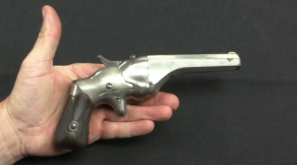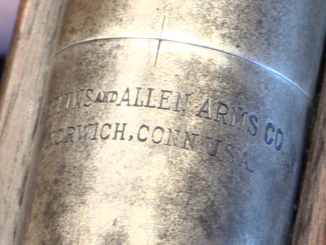While the Henry Repeating Rifle had been an serious leap forward in firearms capability, it was not without problems. The biggest single weakness of the Henry was its magazine. The tube magazine was open to dirt and debris, the follower could easily come to rest on the shooter’s hand or anything used as a rest and stop the weapon from feeding, and the while system was rather prone to being damaged.
These problems would all be addressed with the addition of Nelson King’s new loading gate idea, which allowed Winchester to omit the exposed follower entirely, solving a bunch of complaints all at once. The new system was more durable, more reliable, and allowed the rifle to be loaded without the awkward manipulation required by the Henry. The King improvement also allowed the addition of a wooden handguard, which was a welcome addition – it does not take very many black powder rounds for a barrel to become uncomfortably hot to the touch.
At the same time that these improvements were being made, company politics were taking shape to end Benjamin T. Henry’s involvement with the company. Henry attempted to take over ownership of the company because he felt he was not profiting as much as he should, but he had assigned his patent rights to Oliver Winchester in exchange for his contract to manufacture the guns. As a result, Winchester was able to create a new company (the Winchester Repeating Arms Company) with full rights to the design patents and sideline Henry.
The 1866 rifle, which was formally called simply the Winchester Repeating Rifle would continue to use the .44 Henry Rimfire cartridge, but would be made in a wider variety of configurations than the Henry had been, including carbine, rifle, and musket barrel lengths. It would prove to be a very popular rifle, and opened the path to further improvement, as it put the Winchester company on excellent financial footing.




Misspeak: You meant WINCHESTER made 170k at 6.58 it believe.
All I can say – this is extremely well laid out story; good stuff thru-out. Looking forward to next number!
When does Browning jump into the picture?
Browning’s first production lever action was the Winchester 86–it could fire heavier cartridges. The big one was the Winchester 94, it was just right. Reliable, just the right size, and could be chambered in 30-30–an early smokeless round just right for deer hunting. The 30-30 round is close, in bullet weight and velocity, to the 7.62 x 39 (except it must use round nose bullets that reduce the range). More than 7 million have sold.
It was too late for civilian use in the Indian conflicts, but was popular in the various civil wars in Mexico around the turn of the century.
There is just something about lever actions. Very easy to carry and fun to shoot. Compact guns for their firepower. Their flat receivers pack well on horses, a big deal back then.
“Mexico”
There is even song charro avitia carabina 30-30
https://www.youtube.com/watch?v=qntzxpCMXls
“(…)30-30–an early smokeless round just right for deer hunting. The 30-30 round is close, in bullet weight and velocity, to the 7.62 x 39 (except it must use round nose bullets that reduce the range)(…)”
Concept of intermediate-like cartridge is older than it might look, for example .32-40 Ballard cartridge was introduced in 1884. It was available in Marlin lever-actions like Model 1881 or Model 1883, see photo here: http://www.cabelas.com/product/Marlin-Model-Cal/1931289.uts
Also, lever guns are about the only genuinely ambidextrous longarms other than pump-actions and single-shots. Yes, I know about self-loaders; I also know I used to have to fire a Ruger Mini-14 off my right shoulder to avoid getting hot brass in my face. Even Marlin lever guns like the 1895 .45-70 are more polite to us southpaws.
cheers
eon
“know about self-loaders; I also know I used to have to fire a Ruger Mini-14 off my right shoulder to avoid getting hot brass in my face. ”
This depend on particular design, it is possible to make such weapon, but it has low priority in most military fire-arms designed, if I am not mistaken.
S&W Model 1940 Light Rifle is example how case ejection might be solved.
“Browning”
Basing on http://matthewsbrowning.com/include/_bio.html I would say that cooperation between Matthew S. Browning and Winchester started around 1885 (see Winchester Model 1885 single-shot rifle)
One other lever action – Browning connection is that his first self-loader was a modified lever action. It was not a production item, but apparently led to the development of the Colt “potato digger.”